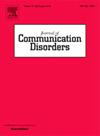在芬兰大脑出生队列研究中,婴儿气质预测早期沟通技能。
IF 2.1
3区 医学
Q2 AUDIOLOGY & SPEECH-LANGUAGE PATHOLOGY
引用次数: 0
摘要
研究已经确定,气质和语言发展的维度在童年时期是相关的。然而,到目前为止,从婴儿期到幼儿期的纵向研究,涵盖了所有气质维度,除了新兴的语言技能之外,还涵盖了言语前交流。现有的研究结果尚无定论。目前的研究是我们之前的研究(N = 91)在一个大队列样本(N = 1200和1039取决于分析)的扩展。在6个月和12个月大的时候评估气质(积极情绪、消极情绪和新兴的自我调节),在14个月大的时候评估手势和接受性词汇。作为先前研究的延伸,我们还对30个月大的幼儿的表达性词汇和句子复杂性进行了评估。所有评估均采用家长报告。采用多元线性回归分析研究相关性。积极情绪和自我调节的气质特征正向预测除句子复杂性外的所有交际技能。积极情绪对手势、接受性词汇和表达性词汇的影响分别为10- 11%、4- 5%和1- 3%。自我调节对手势、接受性词汇和表达性词汇的影响分别为4- 6%、2- 3%和0- 1%。结果与我们之前的研究结果一致,但也强调了积极情绪与自我调节、手势和词汇之间微弱的纵向正相关。然而,与语言技能相比,手势技能的关联性明显更强。关联的纵向减弱表明,进入幼儿期,影响语言发展的其他因素取代了婴儿气质的作用。本文章由计算机程序翻译,如有差异,请以英文原文为准。
Infant temperament predicts early communicative skills in the FinnBrain Birth Cohort Study
Studies have established that dimensions of temperament and language development are associated in childhood. Insofar, however, longitudinal studies from infancy into toddlerhood accounting for all temperament dimensions and covering preverbal communication in addition to emerging verbal skills are scarce. Existing findings are inconclusive.
The current study is an extension of our previous study (N = 91) on a large cohort sample (N = 1200 and 1039 depending on analysis). Temperament (positive emotionality, negative emotionality and emerging self-regulation) was assessed at 6 and 12 months of age and gesturing and receptive vocabulary at 14 months. As an extension to the previous study, expressive vocabulary and sentence complexity in toddlerhood, at 30 months, were also assessed. All assessments utilized parent reports. Associations were studied by multiple linear regression analysis.
The temperament traits of positive emotionality and self-regulation positively predicted all communicative skills except sentence complexity. Positive emotionality accounted for 10–11 % of the variance in gesturing, 4–5 % in receptive vocabulary and 1–3 % in expressive vocabulary. Self-regulation accounted for 4–6 % of the variance in gesturing, 2–3 % in receptive vocabulary and 0–1 % in expressive vocabulary.
Results aligned with the findings of our prior study but also highlighted weak longitudinal positive associations between positive emotionality and self-regulation and gesturing and vocabulary. However, associations were notably stronger with gesturing compared to verbal skills. Longitudinal weakening of associations suggests the role of infant temperament is replaced by other factors influencing language development moving into toddlerhood.
求助全文
通过发布文献求助,成功后即可免费获取论文全文。
去求助
来源期刊

Journal of Communication Disorders
AUDIOLOGY & SPEECH-LANGUAGE PATHOLOGY-REHABILITATION
CiteScore
3.30
自引率
5.90%
发文量
71
审稿时长
>12 weeks
期刊介绍:
The Journal of Communication Disorders publishes original articles on topics related to disorders of speech, language and hearing. Authors are encouraged to submit reports of experimental or descriptive investigations (research articles), review articles, tutorials or discussion papers, or letters to the editor ("short communications"). Please note that we do not accept case studies unless they conform to the principles of single-subject experimental design. Special issues are published periodically on timely and clinically relevant topics.
 求助内容:
求助内容: 应助结果提醒方式:
应助结果提醒方式:


